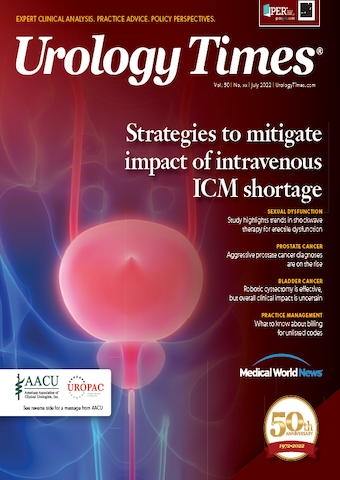Publication
Article
Urology Times Journal
Strategies to mitigate impact of intravenous ICM shortage
Author(s):
"The global shortage of ICM has necessitated rapid adaptation of workflows and clinical pathways, which are particularly important for practicing urologists who are evaluating patients for hematuria," write Yair Lotan, MD, and colleagues.
Yair Lotan, MD

Lotan is a professor of urology; chief of urologic oncology; the Jane and John Justin Distinguished Chair in Urology, in Honor of Claus G. Roehrborn, MD; and vice chair of clinical affairs at the University of Texas Southwestern Medical Center in Dallas. Barocas is a professor of urology and executive vice chair of the Department of Urology at Vanderbilt University Medical Center in Nashville, Tennessee. Boorjian is the Carl Rosen Professor and
Daniel Barocas, MD, MPH, FACS

Chair of the Department of Urology and the Director of the Urologic Oncology Fellowship at Mayo Clinic in Rochester, Minnesota. Souter is the owner and lead methodologist of Nomadic EBM Methodology. Raman is a professor and interim chair of the Department of Urology at Penn State Health Milton S. Hershey Medical Center in Pennsylvania.
Stephen A. Boorjian, MD

The lockdown of more than 26 million people in Shanghai, China, on March 31, 2022, following a spike in COVID-19 cases impacted GE Healthcare’s primary pharmaceutical manufacturing facility for iohexol (Omnipaque) iodinated contrast media (ICM). As of mid-May 2022, the FDA continues to report shortages of GE Healthcare’s iohexol and iodixanol intravenous (IV) contrast media products.1 GE Healthcare anticipates product supply availability to improve the week of May 23, but a 20% allocation level has been established until then.1
Jay D. Raman, MD, FACS

The acute shortages impacting hospitals and imaging centers globally have emphasized the importance of judicious resource allocation. The evaluation of microscopic hematuria (MH) is particularly relevant to examine in this setting, based on both its prevalence (variously estimated to occur in 6.5% of the population) and the fact that the diagnostic evaluation for hematuria has historically been heavily weighted to the use of computer tomography (CT) imaging with iodixanol IV contrast.2 Indeed, prior guideline recommendations have essentially suggested CT urogram (CTU) with cystoscopy as the evaluation for all patients with microhematuria who are older than 35 years.2
Notably, the updated 2020 American Urological Association (AUA)/Society of Urodynamics, Female Pelvic Medicine and Urogenital Reconstruction (SUFU) guidelines for MH help to address the issue of contrast utilization by both providing a risk-stratified approach based on likelihood for harboring malignancy—whereby IV contrast–based CTU is recommended only for high-risk patients—and by outlining alternative modalities to the imaging evaluation.3 Specifically, risk strata were created based on clinical features, including patient age, gender, smoking history, extent of hematuria on urinalysis (UA), and history of risk factors for urothelial cancer (eg, exposures). In patients with MH classified as low-risk, the guidelines recommend clinicians should engage patients in shared decision-making to decide between either repeating a UA within 6 months or proceeding with cystoscopy and renal ultrasound.3 Meanwhile, for patients classified as intermediate risk of malignancy, the guidelines offer cystoscopy with renal ultrasound for evaluation.3 As such, the use of multiphasic CTU, which utilizes ICM and includes imaging of the urothelium, to evaluate MH is recommended by the new guidelines only for high-risk patients.
This risk-based approach for MH evaluation represents 1 important step the medical/urologic community can adopt to restrict IV contrast utilization. These recommendations were based on the balance of risks and benefits, as CTU has additional cost and toxicity relative to renal ultrasound and a relatively small yield of identifying malignancy, especially in low- and intermediate-risk patients, where the incidence of upper tract malignancy is very low. Further, the guidelines offer that for patients in the high-risk category, magnetic resonance urography (MRU) may be utilized to image the upper urinary tract, which would provide an alternative to utilizing CT IV contrast.3
Data on the performance of imaging with noncontrast CT, MRU, and renal ultrasound were collated as part of the analysis for the AUA/SUFU guidelines. Because all modalities are quite sensitive for detection of renal cortical tumors—most of which are renal cell carcinoma (RCC)—the comparisons among modalities focused on performance characteristics for detection of upper tract urothelial carcinoma (UTUC), which is a relatively rare finding in patients with microhematuria.
The current gold standard for upper tract imaging is CTU. Four studies identified by the systematic review underpinning the guidelines reported on the diagnostic test characteristics of CTU for the detection of UTUC and RCC in a hematuria population.4-7
Based on pooling of the 6 sensitivities and specificities in the 4 studies, the pooled sensitivity for CTU detection of UTUC or RCC was 94.16% (95%CI, 83.77%-98.05%) and the specificity was 99.09% (95%CI, 96.59%-99.76%).4-7 Only 1 study reported on the diagnostic ability of nonenhanced CT for UTUC detection in solely MH patients.4 The study defined pathologic confirmation of malignancy as the reference standard. In patients who underwent CTU for initial evaluation of asymptomatic MH, the noncontrast images of a randomized portion of the cases was categorized as normal, and all cases categorized as suspicious and benign were submitted to 2 blinded radiologists who independently classified each study into 1 of the aforementioned categories. When compared with the CTU reports, the negative predictive values of noncontrast images were 97.25% and 94.92% for radiologist 1 and radiologist 2, respectively, with an associated specificity of 88.6% and 97.95%. Of the 5 true upper tract malignancies, both blinded radiologists correctly identified 4 of the 5.
Two studies reported on the diagnostic test characteristics of ultrasound for the detection of UTUC and RCC.5,8 Tan et al5 reported on detection of both UTUC and RCC, whereas Unsal et al8 reported on detection of only UTUC.5 Both studies defined pathologic confirmation of malignancy as the reference standard. In the Tan et al study, the sensitivity for RCC was 85.7% (95% CI, 62.1%-97.5%) with a specificity of 99.2% (95% CI, 98.8%-99.5%), but the sensitivity for UTUC was low at 14.3% (95% CI, 0.9%-49.4%).5 The Unsal et al study had a much higher sensitivity for UTUC of 96%, with specificity of 100%.8
One study reported on the diagnostic test characteristics of MRU for the detection of neoplastic lesions in patients with MH or gross hematuria.9 Martingano et al defined pathologic confirmation of malignancy as the reference standard. In this study, the sensitivity for RCC or UTUC was 83% and specificity was 86% based on review by 2 radiologists.9
Alternative forms of contrast
Although there is not a considerable amount of data, there are other options for use of oral ICM, such as sorbitol-mannitol-xanthan gum (Breeza; Beekley Medical) and diatrizoate meglumine and diatrizoate sodium solution USP (Gastrografin; Bracco Diagnostics Inc).10 Similarly, sorbitol-mannitol-xanthan gum and iothalamate meglumine (Cysto-Conray; Guerbet LLC) can be used for cystography, retrograde ureterography, as well as for percutaneous renal access and nephrostomy procedures.10
Summary and recommendations
The global shortage of ICM has necessitated rapid adaptation of workflows and clinical pathways, which are particularly important for practicing urologists who are evaluating patients for hematuria. Based on the meta-analyses for the AUA/SUFU guidelines3 for evaluation of microhematuria, CTU has the highest sensitivity for detection of UTUC compared with unenhanced CT, MRU, and renal ultrasound. However, given the rarity of UTUC11—particularly in the setting of the current shortage of ICM—we believe the risk-stratified approach to evaluation, as recommended in the 2020 guidelines, offers appropriate resource conservation. Indeed, to review:
• For patients with low-risk microhematuria undergoing evaluation, consider shared decision-making for a period of observation with repeat UA, or evaluate with a cystoscopy and renal ultrasound. For patients with intermediate-risk microhematuria, cystoscopy with renal ultrasound is recommended.3
• For patients with high-risk microhematuria, the guidelines do recommend CTU. However, the authors believe that in the setting of ICM shortage, a tiered approach may be considered, with initial renal ultrasound or noncontrasted CT with subsequent CTU for those with abnormal findings. Importantly, MRU represents an alternative modality to evaluate high-risk patients, albeit with potential cost and access implications.
• Patients with gross (macroscopic) hematuria are at highest risk for receiving a diagnosis of a urologic malignancy among patients with hematuria. These patients should be prioritized for CTU, again, with the option of using MRU as the initial imaging study, pending local ICM availability.
Other mitigation strategies for urology patients include the following:
• Consult with local radiology colleagues to discuss use of alternative contrast agents for cystography, retrograde ureterography, and for percutaneous renal access and nephrostomy procedures.
• Delaying routine cancer surveillance imaging or utilizing MR-based imaging for cancer follow-up as available/appropriate
• Using MRI with and without contrast to delineate and stage renal cortical tumors
The authors recognize that ICM is also relevant in multiple other clinical settings urologists manage, including new cancer diagnosis staging, and evaluation of suspected perioperative complications. Thus, in addition to monitoring supplies of ICM, the leadership team must also monitor availability of the alternative imaging strategies, as large-scale diversion of contrasted CT into MRI and ultrasound could lead to resource shortages in those areas. Such alternatives include delaying the timing of CTs requiring IV contrast and employing lower-dose regimens when ICM is necessary. It is critical for urologists to communicate with their radiology colleagues, pharmacy colleagues, and administrative leaders to form a local strategy for conserving supplies while still delivering the highest-quality care available.
A comprehensive plan would include designating a leadership team with all relevant disciplines represented; gathering information, such as local supply of ICM and local availability of alternative imaging options; establishing clinical protocols to prioritize use of ICM in crucial scenarios while conserving its use in others; and establishing a communication plan to disseminate the information. A recent study highlights some short-, mid-, and long-term strategies to manage the shortage of iohexol.10
References
1. Shortage of contrast media for CT imaging affecting hospitals and health systems. American Hospital Association. May 12, 2022. Accessed June 7, 2022. https://bit.ly/3xbGoOX
2. Davis R, Jones JS, Barocas DA, et al. Diagnosis, evaluation and follow-up of asymptomatic microhematuria (AMH) in adults: AUA guideline. J Urol.2012;188(suppl 6):2473-2481. doi:10.1016/j.juro.2012.09.078
3. Barocas DA, Boorjian SA, Alvarez RD, et al. Microhematuria: AUA/SUFU guideline. J Urol.2020;204(4):778-786. doi:10.1097/JU.0000000000001297
4. Janssen KM, Nieves-Robbins NM, Echelmeier TB, Nguyen DK, Baker KC. Could nonenhanced computer tomography suffice as the imaging study of choice for the screening of asymptomatic microscopic hematuria? Urology.2018;120:36-41. doi:10.1016/j.urology.2018.07.013
5. Tan WS, Sarpong R, Khetrapal P, et al. Can renal and bladder ultrasound replace computerized tomography urogram in patients investigated for microscopic hematuria? J Urol.2018;200(5):973-980. doi:10.1016/j.juro.2018.04.065
6. Chen CY, Tsai TH, Jaw TS, et al. Diagnostic performance of split-bolus portal venous phase dual-energy CT urography in patients with hematuria. AJR Am J Roentgenol.2016;206(5):1013-1022. doi:10.2214/AJR.15.15112
7. Ascenti G, Mileto A, Gaeta M, Blandino A, Mazziotti S, Scribano E. Single-phase dual-energy CT urography in the evaluation of haematuria. Clin Radiol.2013;68(2):e87-e94. doi:10.1016/j.crad.2012.11.001
8. Unsal A, Calişkan EK, Erol H, Karaman CZ. The diagnostic efficiency of ultrasound guided imaging algorithm in evaluation of patients with hematuria. Eur J Radiol.2011;79(1):7-11. doi:10.1016/j.ejrad.2009.10.027
9. Martingano P, Cavallaro MF, Bertolotto M, Stacul F, Ukmar M, Cova MA. Magnetic resonance urography vs computed tomography urography in the evaluation of patients with haematuria. Radiol Med.2013;118(7):1184-1198. doi:10.1007/s11547-013-0955-6
10. Grist TM, Canon CL, Fishman EK, Kohi MP, Mossa-Basha M. Short-, mid-, and long-term strategies to manage the shortage of iohexol. Radiology.Published online May 19, 2022. doi:10.1148/radiol.221183
11. Commander CW, Johnson DC, Raynor MC, et al. Detection of upper tract urothelial malignancies by computed tomography urography in patients referred for hematuria at a large tertiary referral center. Urology.2017;102:31-37. doi:10.1016/j.urology.2016.10.055

Newsletter
Stay current with the latest urology news and practice-changing insights — sign up now for the essential updates every urologist needs.



























